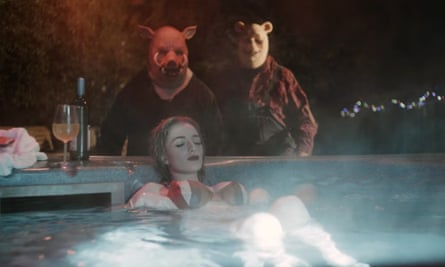
Oh, bother: the Winnie the Pooh slasher movie is a bloody mess
In the new film Winnie the Pooh: Blood and Honey, AA Milne’s beloved storybook bear embarks upon a murderous rampage, driven to homicidal madness by Christopher Robin’s abandonment for adulthood.
As explained by a prologue in crude stick-figure animation, a cold winter in the Hundred Acre Wood left Pooh and the rest of the gang with no choice but to cannibalize melancholic donkey Eeyore for survival, which marked a nightmarish surrender of all civility for a return to their basest beastly natures. A warped Pooh and Piglet, the latter wielding the savage force of 30 to 50 feral hogs, loose their unslakable hunger for carnage on a cadre of young hotties unaware that their weekend getaway to the woods is about to uphold horror-movie tradition in grisly fashion. As a buxom influencer snaps a series of bikini selfies in the cabin’s hot tub, Piglet creeps up behind her with a chloroform rag, then Pooh drives a car directly over the incapacitated woman’s skull until the pressure makes her eyeball pop out. Oh, bother!
If you assumed that it would be a blustery day in hell before Disney allowed this to happen to one of their IP superstars, you’d be right. On 1 January 2022, the content of Milne’s first story about the menagerie of philosophically inclined imaginary friends entered the public domain and legally threw open the reinterpretive floodgates. Artists far and wide could suddenly do whatever they pleased with or to Pooh, and director Rhys Frake-Waterfield wasted no time in lunging for the lowest-hanging fruit. He aims to scandalize with his intentional desecration of a kiddie icon, his stated goal nothing less than to “ruin everyone’s childhood”. But his feature debut, seemingly produced for $38 and improbably breaking into multiplexes with an assist from Fathom Events, illustrates the pitfalls and limitations along with the irreverent potential of the free-use-sploitation cinema sure to proliferate as more brand-name characters are freed from their contractual shackles.
Pooh belongs to the people now, though Blood and Honey can’t help raising the ontological question of how much alteration his image can sustain before he’s stripped of his essential Pooh-ness. While the 1926 short story collection Winnie the Pooh may be up for grabs, Disney’s representation of him will remain under copyrighted lock and key for nearly 40 more years, which mandated Frake-Waterfield distinguish his work from the genuine article clearly enough that no one could confuse them.
That means no catchphrases, no red-shirt-sans-pants ensemble, no head stuck in the pot labeled HUNNY while his legs wiggle helplessly behind him. Pooh has been made over by way of The Texas Chain Saw Massacre, now a hulking, silent humanoid in a dirty pair of overalls and lumberjack flannel. If not for the constant mentions by name, the film would be a bog-standard chop-’em-up cheapie in which the killer happens to be wearing a Pooh mask from under which his human mouth and eyes are both visible.
It’s a ramshackle, dashed-off operation with little to recommend it as cinema, but judging by the shrieks of delight and robust round of applause at the opening night screening in New York’s Regal Union Square theater, there’s a market for that. And the makers of Blood and Honey apparently know it too, the brazen anti-resolution of the non-ending – never a good sign when someone in the back yells “THAT WAS IT?!” – cuing up a title card that teases a sequel in the works. This green light is a declaration of hubris, and yet it’s already been vindicated by a nearly million-dollar take on opening night, schlock enthusiasts having smelled blood in the water and turned out in droves for a feeding frenzy.
As the public domain window advances to cover more and more of the 20th century, viewers can expect a cottage industry to spring up around intellectual properties with opened access, one step up from the no-budget knockoffs of The Asylum. While the titles to come won’t enjoy the novelty factor of Pooh’s rushed-to-release slaughter spree (confirmed films include R-rated takes on Bambi and Peter Pan), they will have an advantage in not needing to tiptoe around the most well-known version of the concept. Specific trademarks could still complicate matters, however; Mickey Mouse, for example, enters the public domain at the beginning of next year. But any enterprising deviant seeking to depict the fan-favorite rodent in flagrante delicto with Dracula cannot include any elements of appearance introduced after 1928’s short Steamboat Willie.

All of this is to say that even when purloining someone else’s idea to make a quick-and-dirty buck, expertise and effort make a difference. (Any trash connoisseur will tell you that it’s a fine line between so-bad-it’s-good and just bad.) It’s a primal human impulse to corrupt our totems of juvenile innocence, a natural part of shedding the naiveté of youth for the obscenity of the grown-up world. But from Tijuana bibles getting pin-up girl Betty Boop fully nude to the stage play Dog Sees God, in which Charlie Brown and his pals have aged into broken, dysfunctional teens, the most successful perversions have drawn on the unique qualities that made their fictitious stars popular in the first place.
If a person is going to do a murderous Pooh movie, the least they owe to their audience is a passable simulacrum of Pooh, imbued with an identifiably Pooh-like essence. Creative license lies at the heart of the argument in favor of public domain, the notion that concepts shouldn’t be off-limits to artists looking to engage with them. Anything short of that is just slapping a proper noun on generic chaff as a shortcut to distinction, an act of lazy greed that would deserve any litigation coming to it. And in the end, isn’t making ordinary citizens side with Disney’s legal department far more offensive than foisting unforgivable atrocities on literature’s cuddliest bear?
